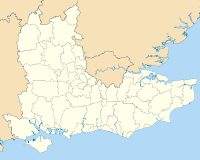Gravesham
Gravesham
Borough of Gravesham | |
|---|---|
 Gravesham located within Kent | |
| Sovereign state | United Kingdom |
| Constituent country | England |
| Non-metropolitan county | Kent |
| Status | Borough |
| Admin HQ | Gravesend |
| Incorporated | 1 April 1974 |
| Government | |
| • Type | Non-metropolitan District Council |
| • Body | Gravesham Borough Council |
| • Leadership | Member of Parliament (Conservative) |
| • MP | Adam Holloway |
| Area | |
| • Total | 38.23 sq mi (99.02 km2) |
| Area rank | 216th (of 309) |
| Population (mid-2019 est.) | |
| • Total | 106,939 |
| • Rank | 223rd (of 309) |
| • Density | 2,800/sq mi (1,100/km2) |
| • Ethnicity | 87.8% White 8.5% S.Asian 1.4% Black 1.3% Mixed Race 1.0% Chinese or Other |
| Time zone | UTC0 (GMT) |
| • Summer (DST) | UTC+1 (BST) |
| ONS code | 29UG (ONS) E07000109 (GSS) |
| OS grid reference | TQ647740 |
| Website | www.gravesham.gov.uk |

Gravesham (/ˈɡreɪvʃəm/ GRAYV-shəm) is a local government district with borough status in north-west Kent, England. Its administrative centre[1] and largest town is Gravesend, which was known as Gravesham in ancient times.
Gravesham was formed on 1 April 1974 by the merger of the Municipal Borough of Gravesend with Northfleet Urban District and part of Strood Rural District, under the Local Government Act 1972. It borders the Borough of Dartford and Sevenoaks District to the west, the Borough of Tonbridge and Malling to the south, the Medway unitary authority to the east and the Thurrock unitary authority of Essex to the north, via the River Thames.
Gravesham is twinned with Cambrai in Hauts-de-France, France. The present borders of Gravesham parliamentary constituency are almost the same as those of the borough.
History[]
Robert Heath Hiscock LL.B., F.S.A., Chairman of the Gravesend Historical Society, in the foreword to his book, 'A History of Gravesend' (Phillimore, 1976) wrote:
- "The name Gravesham appears only in the Domesday Book, 1086, and was probably the error of a Norman scribe. It was 'Gravesend' in the Domesday Monarchorum c.1100, and 'Gravesende' in the Textus Roffensis c. 1100. It is strange that this "clerical error" should now have been adopted as the name of the new Council".
Housing and architecture[]
Housing varies from mid rise to low rise, particularly in the villages. The district has 12 buildings listed in the highest category of the national grading system, Grade I, three of which are private residences:
- Gadshill Place in Higham
- Luddesdown Court in Luddesdown
- Nurstead Court in Meopham
Cobham Hall, also in the highest architectural category,[2] is a stately home which was formerly the seat of the Earls of Darnley: since 1965 it has been an independent girls' school. Cobham Park is Grade II*-listed which is listed separately in the gardens and parklands category of classification approved by the Department of Culture, Media and Sport;[3] and includes the remains of a Roman villa.[2][4]
The other Grade I-listed buildings in the borough comprise its ancient parish churches.
Governance[]
See also[]
References[]
- ^ Reserved, Gravesham Borough Council - All Rights (1 January 2016). "Home". www.gravesham.gov.uk.
- ^ a b Historic England. "Cobham Hall (1000182)". National Heritage List for England. Retrieved 1 June 2014.
- ^ "Gravesham Listed Building Guidance Notes". Archived from the original on 21 December 2014. Retrieved 21 December 2014.
- ^ Historic England. "Romano-British villa and 19th century reservoir in Cobham Park (1012964)". National Heritage List for England. Retrieved 1 June 2014.
External links[]
| Wikimedia Commons has media related to Gravesham. |
- Gravesham
- Thames Gateway
- Local authorities adjoining the River Thames
- Non-metropolitan districts of Kent


